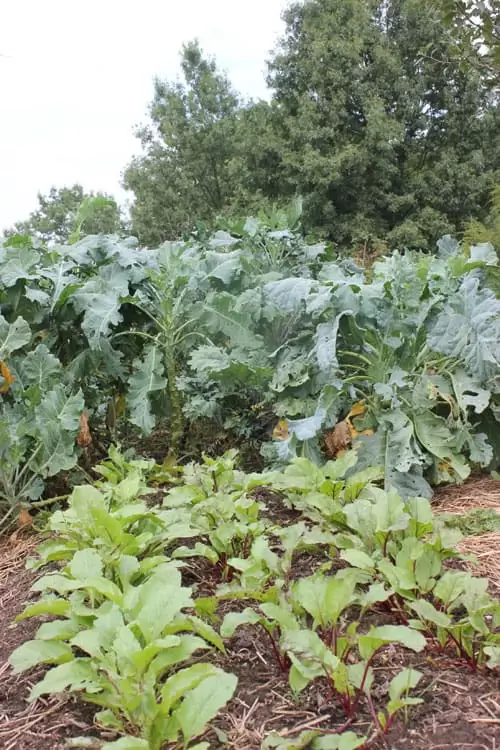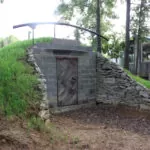What is a root cellar garden? I like to think of it as a garden that provides you with a large quantity of food that you can store in a root cellar. Think root vegetables, apples, pears, potatoes, squash, onions, some brassicas, etc. Planting a root cellar garden takes a little bit of planning to ensure that you:
- Have enough space
- Are planting the right varieties
- Are harvesting at the correct time
This article will teach you the basics of planning and planting your own root cellar garden so you can maximize the amount of homegrown food on your table and minimize your expenses at the grocery store.
Why Root Cellar?
I love growing food, and it’s a priority of mine to grow and consume local, organic fruits and vegetables. When I started gardening (way back in 1999!), I lived in the Willamette Valley of Oregon where I was able to garden year round and access additional local, organic food at the natural food store, farmer’s market, or winter CSA.
I still preserved a lot of food, but in general, I could walk out into the garden in February and still find plenty to eat.
In 2012, we moved to rural Northeast Missouri, where it was challenging to source locally produced food in the winter-early spring unless you grew or preserved it yourself.
Now we live in Central Vermont, gardening in zone 4b. Because I don’t (yet) have a high tunnel, my garden harvest is limited to roughly May – November. Fortunately, Vermont is full of beautiful, locally produced food, but it can be expensive.
To meet their needs for homegrown food, many of my friends and neighbors can large quantities of food in the summer months. This is certainly one great way to preserve the abundance of summer. However, I’m one of those rare homesteaders that really dislikes canning!
Canning is labor intensive and energy intensive, and preserving the bulk of our food with that technique is not something that fits well into our busy life. Instead, we reserve our canning efforts for jams, sauces, and condiments, and focus on storing fresh food in a root cellar or basement.
Planning a Root Cellar Garden
To make sure I have access to locally grown food year-round, I have shifted my gardening priorities to come up with the alternative gardening paradigm – a root cellar garden – that I’ll share with you today.
The first step in planning a root cellar garden is to anticipate your family’s year-round food needs.
As I mentioned, here in Vermont, I essentially have access to year-round locally grown food through a combination of Winter CSAs, Winter farmer’s markets, and several good natural food co-ops. But it can get very expensive to buy local and organic all winter long.
I know my family will eat and enjoy a variety of food that stores well in a root cellar – we love carrots, parsnips, beets, potatoes, squash, and apples. Plus, these are the kinds of foods that will actually fill our bellies. So it makes sense for me to dedicate garden space to these storage crops.
My overall garden plan is to:
1) Get a jump start on spring planting with the use of row cover and plastic. Last year I was able to plant some greens and peas in April and began harvesting salad and kale in May.
2) Plant fresh-eating quantities of summer crops such as cucumbers, peppers, zucchini, and basil. I have connections with local farmers that can provide me with larger quantities for preservation.
3) Dedicate space to a fall planting of kale, spinach, and other greens. Learn more about fall gardening in Homestead Honey’s Guide to Fall Gardening.
4) Plant a storage crop garden, focusing on foods that I can harvest in late fall and store in my root cellar for winter eating. (I also supplement my harvest by purchasing storage crops in bulk from other farmers.)
Succession Planting
This multi-season approach to gardening requires a lot of planning and juggling of beds. I spend time with paper and pencil mapping out each garden bed and deciding how to best utilize the space I have available. I will always practice succession planting, or the act of following one plant with another.
Succession planting is especially useful if you want to store a large amount of food in a root cellar, and also enjoy fresh harvests. For instance, if I plant potatoes in the spring, I will have an ample crop to enjoy in the late summer. I can also plant a second crop of potatoes for storage.
The same goes for beets or carrots. I like to space out my planting every 14 days or so. I’ll focus on quick growing, fresh eating carrots and beets for the summer months, and then shift to storage varieties in the late summer into the fall.
Read more: 7 Ways to Grow More Food in Less Space with Succession Planting
What to Grow in a Root Cellar Garden
The best gardens are filled with food your family will actually eat, and a root cellar garden is no exception! If you know that your family will turn up their noses at turnips, don’t plant them, even if they are easy to grow and store! Similarly, if you experience crop failures each year with a certain type of vegetable, you may not want to base your plan around that crop.
In general, the foods that we grow/source for storage in our root cellar are:
- Potatoes
- Winter squash
- Onions
- Garlic
- Beets
- Carrots
- Kohlrabi
- Rutabaga
- Cabbage
- Chinese Cabbage
- Turnips
- Apples
- Asian pears
- European pears
Many seed companies will designate good storage varieties, and it’s worth seeking these keepers out.

Tips for Planting
The actual act of planting your root cellar garden is no different than any other crop – you want to pay attention to soil health and fertility that will meet the needs of the various crops you are growing. Some storage crops, like winter squash, are heavy feeders, meaning that you should amend the garden bed with plenty of organic matter, and consider a top-dressing mid-season.
The challenge of planting a root cellar garden is that many of the crops – particularly root vegetables such as carrots, beets, and turnips – need to be planted mid-summer. In the heat of the summer, you will face challenges from extreme heat, drought, and pest pressure.
Let’s talk about each of these challenges and what you can do to mitigate them.
Heat – Extreme heat and humidity makes it difficult to start cool weather crops. I typically direct sow root vegetables and transplant greens and brassicas in July through August – the hottest months of the year!
You can help these crops along by creating shade, either with a physical barrier like a shade cloth, or by planting on the north side of tall plants. For instance, you could plant a row of carrots on the north side of a row of peppers. The carrots will still get sun, but the peppers will help create a bit of natural shade.
Certain plants can be started indoors – broccoli, kale, and cabbage for instance – and the established plants transplanted into your garden.
Drought – Consistent, even moisture is essential to seed germination, and plant health, so you’ll want to come up with an irrigation plan for times when it does not rain. If you have an irrigation system in place, your cool weather crops will thank you!
Pest Pressure – Late summer is a great time to be a pest, but a not-so-great time to be a young seedling! Consider using row cover to protect young plants from pests. I have the hardest time growing Brassicas in the late summer because of cabbage worms. Covering the plants with row cover will help prevent the moths from laying eggs on the plants.
Now that you know the basics of planning and planting a root cellar garden, I encourage you to check out these other resources on root cellaring that I’ve written. And let me know what further questions you may have about root cellaring!
Root Cellaring 101 – What is a Root Cellar, Ideal Conditions, and Uses
Vegetable Storage in a Root Cellar
Building a Homestead Root Cellar











Very informative! Thanks for sharing.
Thank you for reading!